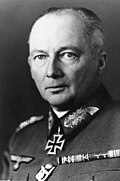| Army Group D | |
|---|---|
| German: Heeresgruppe D | |
| Active | 26 October 1940 – 1945 |
| Country | |
| Branch | |
| Commanders | |
| Notable commanders | |
Army Group D (German : Heeresgruppe D) was a German Army Group which saw action during World War II.
Contents
Army Group D was formed on 26 October 1940 in France, its initial cadre coming from the disbanded Army Group C.
On 15 April 1941, the status of Army Group D was upgraded. From that date on, the commander of Army Group D was also to be considered Oberbefehlshaber West (or OB WEST – the Commander in Chief for the Western Theatre). As a result of this, Army Group D is sometimes incorrectly referred to as Army Group West.



